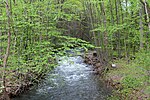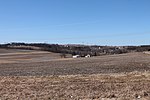Riegel Covered Bridge No. 6
1870 establishments in Pennsylvania1979 disestablishments in PennsylvaniaArson in PennsylvaniaBridges completed in 1870Burr Truss bridges in the United States ... and 7 more
Covered bridges in Columbia County, PennsylvaniaCovered bridges in the United States destroyed by arsonCovered bridges on the National Register of Historic Places in PennsylvaniaDemolished but still listed on the National Register of Historic PlacesNational Register of Historic Places in Columbia County, PennsylvaniaRoad bridges on the National Register of Historic Places in PennsylvaniaWooden bridges in Pennsylvania

The Riegel Covered Bridge No. 6 (also known as the Reuben Reigel's Covered Bridge) was an historic wooden covered bridge that was located in Franklin Township in Columbia County, Pennsylvania.
Excerpt from the Wikipedia article Riegel Covered Bridge No. 6 (License: CC BY-SA 3.0, Authors, Images).Riegel Covered Bridge No. 6
Billmans Road, Franklin Township
Geographical coordinates (GPS) Address Nearby Places Show on map
Geographical coordinates (GPS)
| Latitude | Longitude |
|---|---|
| N 40.912222222222 ° | E -76.513611111111 ° |
Address
Billmans Road 17
17820 Franklin Township
Pennsylvania, United States
Open on Google Maps










